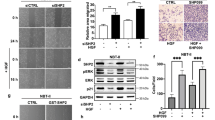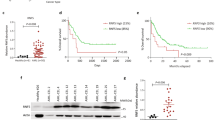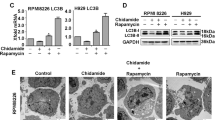Abstract
Synovial sarcoma is a high-grade soft tissue malignancy, for which current cytotoxic chemotherapies provide limited benefit. Although histone deacetylase (HDAC) inhibitors are known to suppress synovial sarcoma in vitro and in vivo, the exact mechanism is not clear. In this study, we report a central role of the transcription factor, early growth response-1 (EGR1), in the regulation of HDAC inhibitor-induced apoptotic cell death in synovial sarcoma. The SS18-SSX oncoprotein, characteristic of synovial sarcoma, maintains EGR1 expression at low levels, whereas it is significantly increased after HDAC inhibitor treatment. On the contrary, EGR1 knockdown leads to a decrease in HDAC inhibitor-induced apoptosis. Moreover, we find that under these conditions phosphatase and tensin homolog deleted in chromosome 10 (PTEN) is upregulated and this occurs through direct binding of EGR1 to an element upstream of the PTEN promoter. Using a combination of gain- and loss-of-function approaches, we show that EGR1 modulation of PTEN contributes to HDAC inhibitor-induced apoptosis in synovial sarcoma. Finally, restoration of EGR1 or PTEN expression is sufficient to induce synovial sarcoma cell death. Taken together, our findings indicate that SS18-SSX-mediated attenuation of an EGR1–PTEN network regulates synovial sarcoma cell survival, and that HDAC inhibitor-mediated apoptosis operates at least in part through reactivation of this pathway.
This is a preview of subscription content, access via your institution
Access options
Subscribe to this journal
Receive 50 print issues and online access
$259.00 per year
only $5.18 per issue
Buy this article
- Purchase on Springer Link
- Instant access to full article PDF
Prices may be subject to local taxes which are calculated during checkout






Similar content being viewed by others
References
Archer SY, Meng S, Shei A, Hodin RA . (1998). p21(WAF1) is required for butyrate-mediated growth inhibition of human colon cancer cells. Proc Natl Acad Sci USA 95: 6791–6796.
Bolden JE, Peart MJ, Johnstone RW . (2006). Anticancer activities of histone deacetylase inhibitors. Nat Rev Drug Discov 5: 769–784.
Bozzi F, Ferrari A, Negri T, Conca E, Luca da R, Losa M et al. (2008). Molecular characterization of synovial sarcoma in children and adolescents: evidence of akt activation. Transl Oncol 1: 95–101.
Brett D, Whitehouse S, Antonson P, Shipley J, Cooper C, Goodwin G . (1997). The SYT protein involved in the t(X;18) synovial sarcoma translocation is a transcriptional activator localised in nuclear bodies. Hum Mol Genet 6: 1559–1564.
Calogero A, Cuomo L, D′Onofrio M, de Grazia U, Spinsanti P, Mercola D et al. (1996). Expression of Egr-1 correlates with the transformed phenotype and the type of viral latency in EBV genome positive lymphoid cell lines. Oncogene 13: 2105–2112.
Calogero A, Lombari V, De Gregorio G, Porcellini A, Ucci S, Arcella A et al. (2004). Inhibition of cell growth by EGR-1 in human primary cultures from malignant glioma. Cancer Cell Int 4: 1.
Condorelli F, Gnemmi I, Vallario A, Genazzani AA, Canonico PL . (2008). Inhibitors of histone deacetylase (HDAC) restore the p53 pathway in neuroblastoma cells. Br J Pharmacol 153: 657–668.
de Bruijn DR, Allander SV, van Dijk AH, Willemse MP, Thijssen J, van Groningen JJ et al. (2006). The synovial-sarcoma-associated SS18-SSX2 fusion protein induces epigenetic gene (de)regulation. Cancer Res 66: 9474–9482.
Downes CP, Bennett D, McConnachie G, Leslie NR, Pass I, MacPhee C et al. (2001). Antagonism of PI 3-kinase-dependent signalling pathways by the tumour suppressor protein, PTEN. Biochem Soc Trans 29: 846–851.
Gan YH, Zhang S . (2009). PTEN/AKT pathway involved in histone deacetylases inhibitor induced cell growth inhibition and apoptosis of oral squamous cell carcinoma cells. Oral Oncol 45: e150–e154.
Gashler A, Sukhatme VP . (1995). Early growth response protein 1 (Egr-1): prototype of a zinc-finger family of transcription factors. Prog Nucleic Acid Res Mol Biol 50: 191–224.
Habold C, Poehlmann A, Bajbouj K, Hartig R, Korkmaz KS, Roessner A et al. (2008). Trichostatin A causes p53 to switch oxidative-damaged colorectal cancer cells from cell cycle arrest into apoptosis. J Cell Mol Med 12: 607–621.
Huang RP, Darland T, Okamura D, Mercola D, Adamson ED . (1994). Suppression of v-sis-dependent transformation by the transcription factor, Egr-1. Oncogene 9: 1367–1377.
Huang RP, Fan Y, de Belle I, Niemeyer C, Gottardis MM, Mercola D et al. (1997). Decreased Egr-1 expression in human, mouse and rat mammary cells and tissues correlates with tumor formation. Int J Cancer 72: 102–109.
Huang RP, Liu C, Fan Y, Mercola D, Adamson ED . (1995). Egr-1 negatively regulates human tumor cell growth via the DNA-binding domain. Cancer Res 55: 5054–5062.
Italiano A, Penel N, Robin YM, Bui B, Le Cesne A, Piperno-Neumann S et al. (2009). Neo/adjuvant chemotherapy does not improve outcome in resected primary synovial sarcoma: a study of the French Sarcoma Group. Ann Oncol 20: 425–430.
Ito T, Ouchida M, Morimoto Y, Yoshida A, Jitsumori Y, Ozaki T et al. (2005). Significant growth suppression of synovial sarcomas by the histone deacetylase inhibitor FK228 in vitro and in vivo. Cancer Lett 224: 311–319.
Khan O, La Thangue NB . (2008). Drug Insight: histone deacetylase inhibitor-based therapies for cutaneous T-cell lymphomas. Nat Clin Pract Oncol 5: 714–726.
Kim J, Lee YH, Kwon TK, Chang JS, Chung KC, Min DS . (2006). Phospholipase D prevents etoposide-induced apoptosis by inhibiting the expression of early growth response-1 and phosphatase and tensin homologue deleted on chromosome 10. Cancer Res 66: 784–793.
Krones-Herzig A, Mittal S, Yule K, Liang H, English C, Urcis R et al. (2005). Early growth response 1 acts as a tumor suppressor in vivo and in vitro via regulation of p53. Cancer Res 65: 5133–5143.
Le Beau MM, Espinosa 3rd R, Neuman WL, Stock W, Roulston D, Larson RA et al. (1993). Cytogenetic and molecular delineation of the smallest commonly deleted region of chromosome 5 in malignant myeloid diseases. Proc Natl Acad Sci USA 90: 5484–5488.
Levin WJ, Press MF, Gaynor RB, Sukhatme VP, Boone TC, Reissmann PT et al. (1995). Expression patterns of immediate early transcription factors in human non-small cell lung cancer. The Lung Cancer Study Group. Oncogene 11: 1261–1269.
Lim FL, Soulez M, Koczan D, Thiesen HJ, Knight JC . (1998). A KRAB-related domain and a novel transcription repression domain in proteins encoded by SSX genes that are disrupted in human sarcomas. Oncogene 17: 2013–2018.
Liu C, Adamson E, Mercola D . (1996). Transcription factor EGR-1 suppresses the growth and transformation of human HT-1080 fibrosarcoma cells by induction of transforming growth factor beta 1. Proc Natl Acad Sci USA 93: 11831–11836.
Liu C, Yao J, de Belle I, Huang RP, Adamson E, Mercola D . (1999). The transcription factor EGR-1 suppresses transformation of human fibrosarcoma HT1080 cells by coordinated induction of transforming growth factor-beta1, fibronectin, and plasminogen activator inhibitor-1. J Biol Chem 274: 4400–4411.
Liu J, Grogan L, Nau MM, Allegra CJ, Chu E, Wright JJ . (2001). Physical interaction between p53 and primary response gene Egr-1. Int J Oncol 18: 863–870.
Lubieniecka JM, de Bruijn DR, Su L, van Dijk AH, Subramanian S, van de Rijn M et al. (2008). Histone deacetylase inhibitors reverse SS18-SSX-mediated polycomb silencing of the tumor suppressor early growth response 1 in synovial sarcoma. Cancer Res 68: 4303–4310.
Ma DZ, Xu Z, Liang YL, Su JM, Li ZX, Zhang W et al. (2005). Down-regulation of PTEN expression due to loss of promoter activity in human hepatocellular carcinoma cell lines. World J Gastroenterol 11: 4472–4477.
Medina V, Edmonds B, Young GP, James R, Appleton S, Zalewski PD . (1997). Induction of caspase-3 protease activity and apoptosis by butyrate and trichostatin A (inhibitors of histone deacetylase): dependence on protein synthesis and synergy with a mitochondrial/cytochrome c-dependent pathway. Cancer Res 57: 3697–3707.
Moradei O, Vaisburg A, Martell RE . (2008). Histone deacetylase inhibitors in cancer therapy: new compounds and clinical update of benzamide-type agents. Curr Top Med Chem 8: 841–858.
Nagai M, Tanaka S, Tsuda M, Endo S, Kato H, Sonobe H et al. (2001). Analysis of transforming activity of human synovial sarcoma-associated chimeric protein SYT-SSX1 bound to chromatin remodeling factor hBRM/hSNF2 alpha. Proc Natl Acad Sci USA 98: 3843–3848.
Nair P, Muthukkumar S, Sells SF, Han SS, Sukhatme VP, Rangnekar VM . (1997). Early growth response-1-dependent apoptosis is mediated by p53. J Biol Chem 272: 20131–20138.
Okcu MF, Munsell M, Treuner J, Mattke A, Pappo A, Cain A et al. (2003). Synovial sarcoma of childhood and adolescence: a multicenter, multivariate analysis of outcome. J Clin Oncol 21: 1602–1611.
Pan L, Lu J, Wang X, Han L, Zhang Y, Han S et al. (2007). Histone deacetylase inhibitor trichostatin a potentiates doxorubicin-induced apoptosis by up-regulating PTEN expression. Cancer 109: 1676–1688.
Roeb W, Boyer A, Cavenee WK, Arden KC . (2007). PAX3-FOXO1 controls expression of the p57Kip2 cell-cycle regulator through degradation of EGR1. Proc Natl Acad Sci USA 104: 18085–18090.
Roeb W, Boyer A, Cavenee WK, Arden KC . (2008). Guilt by association: PAX3-FOXO1 regulates gene expression through selective destabilization of the EGR1 transcription factor. Cell Cycle 7: 837–841.
Roy S, Tenniswood M . (2007). Site-specific acetylation of p53 directs selective transcription complex assembly. J Biol Chem 282: 4765–4771.
Soulez M, Saurin AJ, Freemont PS, Knight JC . (1999). SSX and the synovial-sarcoma-specific chimaeric protein SYT-SSX co-localize with the human Polycomb group complex. Oncogene 18: 2739–2746.
Stimson L, Wood V, Khan O, Fotheringham S, La Thangue NB . (2009). HDAC inhibitor-based therapies and haematological malignancy. Ann Oncol 20: 1293–1302.
Sukhatme VP . (1990). Early transcriptional events in cell growth: the Egr family. J Am Soc Nephrol 1: 859–866.
Sukhatme VP, Kartha S, Toback FG, Taub R, Hoover RG, Tsai-Morris CH . (1987). A novel early growth response gene rapidly induced by fibroblast, epithelial cell and lymphocyte mitogens. Oncogene Res 1: 343–355.
Thaete C, Brett D, Monaghan P, Whitehouse S, Rennie G, Rayner E et al. (1999). Functional domains of the SYT and SYT-SSX synovial sarcoma translocation proteins and co-localization with the SNF protein BRM in the nucleus. Hum Mol Genet 8: 585–591.
Virolle T, Adamson ED, Baron V, Birle D, Mercola D, Mustelin T et al. (2001). The Egr-1 transcription factor directly activates PTEN during irradiation-induced signalling. Nat Cell Biol 3: 1124–1128.
Virolle T, Krones-Herzig A, Baron V, De Gregorio G, Adamson ED, Mercola D . (2003). Egr1 promotes growth and survival of prostate cancer cells. Identification of novel Egr1 target genes. J Biol Chem 278: 11802–11810.
Yu J, Baron V, Mercola D, Mustelin T, Adamson ED . (2007). A network of p73, p53 and Egr1 is required for efficient apoptosis in tumor cells. Cell Death Differ 14: 436–446.
Yu J, de Belle I, Liang H, Adamson ED . (2004). Coactivating factors p300 and CBP are transcriptionally crossregulated by Egr1 in prostate cells, leading to divergent responses. Mol Cell 15: 83–94.
Yu J, Zhang SS, Saito K, Williams S, Arimura Y, Ma Y et al. (2009). PTEN regulation by Akt-EGR1-ARF-PTEN axis. EMBO J 28: 21–33.
Zhao Y, Lu S, Wu L, Chai G, Wang H, Chen Y et al. (2006). Acetylation of p53 at lysine 373/382 by the histone deacetylase inhibitor depsipeptide induces expression of p21(Waf1/Cip1). Mol Cell Biol 26: 2782–2790.
Acknowledgements
We thank Dr Diederik RH de Bruijn (Radbound University Nijmegen Medical Centre, Nijmegen, the Netherlands) for the gift of rabbit polyclonal antibody against SS18–SSX. This work was supported by a grant from the Canadian Cancer Society Research Institute (Grant #018355). Dr TO Nielsen is a scholar of the Michael Smith Foundation for Health Research, and Dr TM Underhill is an Arthritis Society Investigator.
Author information
Authors and Affiliations
Corresponding authors
Ethics declarations
Competing interests
The authors declare no conflict of interest.
Additional information
Supplementary Information accompanies the paper on the Oncogene website
Supplementary information
Rights and permissions
About this article
Cite this article
Su, L., Cheng, H., Sampaio, A. et al. EGR1 reactivation by histone deacetylase inhibitors promotes synovial sarcoma cell death through the PTEN tumor suppressor. Oncogene 29, 4352–4361 (2010). https://doi.org/10.1038/onc.2010.204
Received:
Revised:
Accepted:
Published:
Issue Date:
DOI: https://doi.org/10.1038/onc.2010.204
Keywords
This article is cited by
-
Upregulation of ERK-EGR1-heparanase axis by HDAC inhibitors provides targets for rational therapeutic intervention in synovial sarcoma
Journal of Experimental & Clinical Cancer Research (2021)
-
Histone deacetylase inhibitor ITF2357 leads to apoptosis and enhances doxorubicin cytotoxicity in preclinical models of human sarcoma
Oncogenesis (2018)
-
Translational research in diagnosis and management of soft tissue tumours
Cancer Imaging (2016)
-
Deciphering mechanisms of drug sensitivity and resistance to Selective Inhibitor of Nuclear Export (SINE) compounds
BMC Cancer (2015)
-
SS18-SSX2 and the mitochondrial apoptosis pathway in mouse and human synovial sarcomas
Oncogene (2013)



